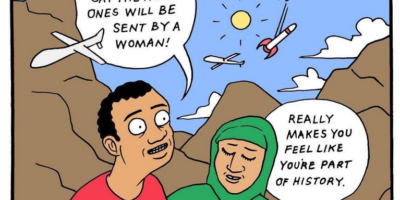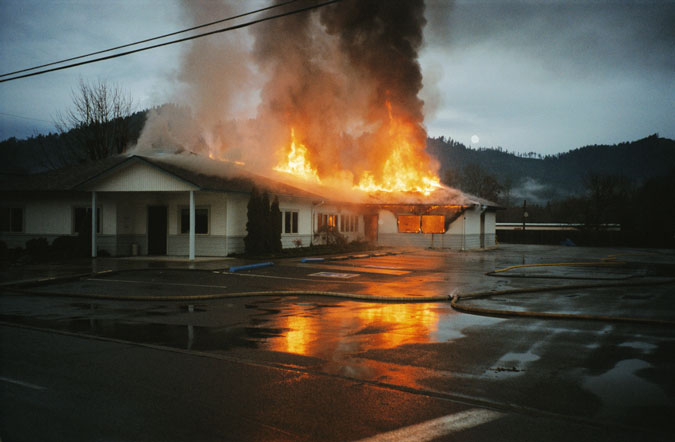Enforcing the Green Scare
By Michael Dean Benton
Curry Marshall, with a degree in Comparative Religion from Swarthmore College and experience as a senior producer at a New York multimedia design firm, got his start in filmmaking by shooting, directing and editing the 2005 documentary Street Fight. The documentary followed the grassroots, underdog candidate Cory Booker’s attempt to unseat Sharpe James, the longtime mayor of Newark, NJ. Marshall impressed audiences and critics with his dogged determination to cover the campaign despite James’ attempt to control all media coverage of his public appearances. The film, which ran as part of a series on PBS and was later recognized with both an Oscar and Emmy nomination, remains an essential document of an actual grassroots campaign running against entrenched party machine politics.
Marshall’s newest documentary, made with cinematographer and co-director Sam Cullman, If a Tree Falls: A Story of the Earth Liberation Front (2011) tells the complex story of environmental Earth Liberation Front activist Daniel McGowan, who faced life in prison for his participation in the burning of two timber facilities. The film has received Best Documentary awards at multiple film festivals, and a Best Documentary Editing Award at the Sundance Film Festival.
Just as Street Fight is essential viewing for grassroots campaigners seeking to intervene in entrenched local power structures, If a Tree Falls is a vital film for committed environmental activists. Not only does the documentary capture embattled environmental activists in the age of the Green Scare opening up to the filmmakers, but most impressive was the filmmakers’ ability to convince law enforcement officials and government lawyers to talk on-record about their perspectives. With that in mind, this is also a film that should spur all American citizens to consider the impact of our current heightened post-9/11 law enforcement policies.
The Green Scare
First introduced into the lexicon in 2003, the Green Scare is a term used by environmental activists to describe the orchestrated campaign to paint their movement as a form of domestic terrorism. With a self-conscious nod to the political repressions of the last century’s numerous “Red Scares” that swept the nation, the Green Scare describes the U.S. government’s use of legal and police tactics to suppress the radical environmental movement. The term seeks to explain why so many environmental activists appear on the FBI’s Most Wanted List, why the jail sentences of environmental activists seem disproportionately long, and how some activists end up in maximum security prisons.
Though If a Tree Falls does not mention the term Green Scare by name, the film dramatically documents the process in action. A key tactic involves using corporate media to influence public perception of environmental and animal rights activist groups as “domestic terrorists.” This designation may seem like a stretch of the imagination. After all, in the past two decades, the United States has experienced multiple assaults on the twin towers in NYC, the horrific bombing of government offices in Oklahoma by Timothy McVeigh, and an incredible increase in violent armed militias and hate groups as Barack Obama became president–none of which have been perpetrated by environmental activists. Nevertheless, starting in the 1990s both local and national news stations amazingly started to apply the loaded term “terrorists” to environmental activists who never harmed or killed a human being in their actions.
When it comes to groups advocating direct environmental actions, law enforcement tactics have likewise focused directly (and often violently) upon environmental activists, intimidating those activists peacefully protesting in the streets while discouraging any citizen attempts to confront the corporations that are destroying the environment. If a Tree Falls provides vivid, difficult-to-watch scenes of police assaulting peaceful, albeit resistant, environmental protesters with strong-arm tactics and chemical weapons. Most memorable is the scene where police officers hold the heads of young female activists who sit with their arms linked together, while other officers apply liquid pepper spray directly to their eyes with Q-Tips. Another scene captures a law enforcement officer who reports that when activists do something that he doesn’t like, it becomes personal for him. Later we hear another officer relate that, with the institution of Post-9/11 Homeland Security policies, the easiest way for law enforcement officers to rise up through the ranks and increase their pay scale is through terrorism enhancement cases. (Jules Boykoff, in Beyond Bullets: The Suppression of Dissent in the United States (AK Press, 2007), details how this intimidation of activists extended to police infiltration of groups that never committed a crime, and the unleashing of paid informants who acted as agent provocateurs–facilitating and encouraging the acceleration of activist actions while reporting back to their home agencies.)
FBI Top Ten List
The top ten list of most wanted domestic “terrorists” by the FBI remains focused on targeting contemporary environmental and animal rights activists, in addition to leftist activists from the 1960s/1970s. Currently three people on the list are environmental and animal right activists possibly involved in a series of ELF arsons in the Pacific Northwest. In a 2009 FBI listing of a new “domestic terrorist,” the FBI stated that “animal rights and environmental extremism pose a significant domestic terror threat. To date, extremists have been responsible for more than 1,800 criminal acts and more than $110 million in damages. Currently, we are investigating approximately 170 such extremist incidents across the country” (emphasis in original).
There is no doubt that there has been significant property damage, as is made clear in the documentary. However, the environmental and animal rights activists have diligently made sure that no physical harm would come to people. Looking at the FBI list one is struck by the political nature of the focus. These are people who object to corporate policies and critique capitalism. There is not one person on the FBI’s top-ten list that reflects a right-to-centrist-political perspective, despite the fact that the worst domestic mass attacks of violence against people has generally come from right-wing extremists.
In recent history, this is even more the case. Most of the dramatic acts of violent domestic terrorism have been from right-wing or fundamentalist extremists: the Jewish Defense League’s bombing attacks during the 1980s, Timothy McVeigh in 1995, Olympic Park Bomber Eric Robert Rudolph from 1996-1998, James W. von Brunn’s attack at the Holocaust Museum in 2009, and Scott Roeder’s murder of George Tiller during a Sunday morning service in a church in 2009.
Commenting in the aftermath of Andrew Joseph Stack III’s airplane attack on the IRS building in Austin, TX in 2010, in which one person was killed and many more injured, constitutional lawyer and author Glenn Greenwald noted how “terrorism” is the “single most meaningless word and the most manipulated.” As the various news networks struggled to keep Stack’s act of violence from being labeled “terrorism,” Greenwald reflected on the absurdity of newscasters’ evasions. Stack wasn’t labeled a terrorist because his written statements reflected current Tea Party concerns and complaints against the government. Greenwald goes on, stating that the “term now has virtually nothing to do with the act itself and everything to do with the identity of the actor.”
Greenwald’s specific comments referred to the discriminatory practices that target Muslims in America, but his point also applies to the way in which the term “terrorist” has been used as a political weapon against groups that may challenge and/or resist the policies and practices of corporations that devastate the environment.
Terrorism enhancement convictions
A central tenet of the Green Scare has been the pursuit of terrorism enhancement sentences against environmental and animal rights activists who commit property crimes. As documented in If a Tree Falls, Daniel McGowan participated as a lookout for one arson, and as a fully engaged participant in a second attack. For these crimes in which no person was physically harmed, he faced a sentence of 300+ years in a maximum security prison. In these cases prosecutors seek what is called a terrorism enhancement conviction. If convicted, defendants are locked in maximum security Communications Management Units. In these prisons there is no sunlight, no fresh air, no activities and extremely limited communication with the outside world.
McGowan, and other Earth Liberation Front members, were brought down by former member-turned-informer Jacob Ferguson, the main instigator in the arsons and (as evidence in the film points out) most likely the first perpetrator of an ELF arson attack. At the time of his work as a snitch gathering information for the FBI, Jules Boykoff reports in Beyond Bullets, he was a full-fledged heroin addict and “receiving between $50,000 and $100,00 for his role as a cooperative witness.” Although confessing to planning and committing numerous arsons across the Pacific Northwest, Ferguson was never charged for any crime. Later, after his role as an informer was over, he was eventually picked up in April on drug dealing charges.
These tactics of harassment, intimidation, infiltration and surveillance have increased in the supposedly heightened security of a post-9/11 America. Most of the targets are social justice, environmental, animal rights, civil liberties, religious anti-war, and anti-corporate activists. As American citizens we should be allowed to freely gather to organize, criticize and protest what we see as harmful practices and policies. These civil liberties are under assault by law enforcement practices that hearken back to the Red Scare paranoia of the McCarthy era and the legal abuses of the FBI’s COINTELPRO. All of us need to consider what this means for our democratic nation, and what the implications are when law enforcement is used as a political tool.





Leave a Reply